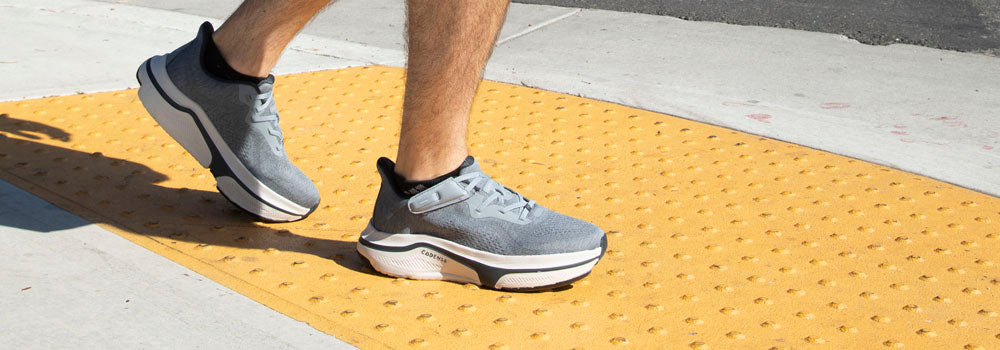How to Keep Walking with MS Related Foot Drop
Mar 07, 2024
Upwards of 2.3 million individuals worldwide are navigating life with multiple sclerosis (MS), and a startling number of them—nearly 80%—will experience some form of foot drop during the course of their condition.
This neurological symptom, though prevalent, isn't the end of the road for mobility.
Advancing methodologies for managing foot drop are making significant strides, enabling many affected by MS to markedly improve mobility and maintain an active lifestyle.
From adaptive strategies to innovative technologies, the possibilities for individuals facing multiple sclerosis foot drop are more hopeful than ever.
Key Takeaways
- Foot drop is a common MS symptom impacting mobility but can be managed effectively.
- Combining physical therapy with assistive devices often yields substantial improvements.
- Customized footwear can enhance stability and reduce the risk of falls.

What is MS Related Foot Drop?
The phenomenon known as foot drop is frequently associated with multiple sclerosis (MS), consisting of compromised mobility where an individual faces challenges in lifting the front part of their foot.
This can be directly traced to the causes of foot drop in multiple sclerosis, which is essentially a disruption in the nerve pathway that connects the brain to the lower extremities. This disruption can cause the foot to drag or hang, markedly increasing the risk of tripping or falling, and consequently affecting an individual's gait pattern.
In the context of MS, this symptom generally stems from poor synchronization between the leg and ankle muscles due to the interrupted nerve signals responsible for their coordination. The additional effort required to walk with a dropped foot escalates fatigue, further hindering mobility. Fortunately, foot drop treatment focuses on interventions that aim to re-establish proper gait and reduce fatigue. These include:
- Physical therapy exercises designed to strengthen and improve flexibility in the affected muscles
- The application of assistive devices for foot drop to support the foot and help maintain a more natural walking pattern
- Functional electrical stimulation, which uses low-level electrical pulses to activate nerves and lift the foot during gait
Beyond these measures, it's crucial to identify and make use of specialized equipment suited to individual needs:
|
Assistive Devices |
Function |
Usage Considerations |
|
Ankle Foot Orthosis (AFO) |
Supports foot positioning |
Worn inside the shoe; can be custom-fitted |
|
Foot-up brace |
Provides dorsal flexion support |
Less obtrusive; attaches to the ankle and shoe |
|
Functional Electrical Stimulation (FES) Device |
Stimulates nerve to lift foot |
Electronic device potentially offering improved mobility but may be cost-prohibitive |
Symptoms of MS Related Foot Drop
By understanding the symptoms associated with MS-related foot drop, healthcare providers and those affected can tailor foot drop exercises and treatments to manage the condition better.
MS Gait
The most observable symptom of foot drop is a distinct change in the way a person walks, known as the gait. The classic sign is the inability to lift the front part of the foot, causing a high-stepping walk similar to climbing stairs. This form of gait alteration is due to the muscle weakness or interruption of nerve signals responsible for lifting the foot, leading to challenges in maintaining an even and stable pace while walking.
MS Fatigue
Fatigue in the context of MS is multifactorial and heavily impacts those with foot drop. The extra effort needed to compensate for the inability to lift the foot normally results in an increased expenditure of energy, leading to an overwhelming sense of exhaustion. This fatigue can contribute to a further decline in motor function, making foot drop symptoms particularly onerous.
MS Spasticity
MS spasticity contributes to the inflexibility and tightness of the muscles, intensifying symptoms of foot drop. It can lead to involuntary muscle spasms, resistance to muscle stretching, and overall discomfort, affecting gait and mobility. The spasticity associated with MS can also cause complications in other areas of the body, such as the hips and lower back, often resulting in a cascading effect that exacerbates foot drop.
|
Symptom |
Description |
Impact on Mobility |
Related Exercises |
|
Altered Gait |
High-stepping and leg lifting |
Difficulty in walking smoothly |
Ankle dorsiflexion, toe-to-heel raises |
|
Fatigue |
Legs feel heavy or unsteady |
Quick exhaustion while walking |
Low-impact aerobic exercises, seated leg lifts |
|
Spasticity |
Muscle tightness and spasms |
Reduced flexibility, balance issues |
Stretching, yoga, pilates |
While symptoms of foot drop and their associated challenges are varied, incorporating targeted foot drop exercises into one's routine can mitigate some of the negative effects of foot drop MS and improve quality of life.
How is MS Related Foot Drop Treated?
The journey to improving mobility for individuals with MS-related foot drop encompasses a combination of techniques, both therapeutic and assistive in nature.

The first line of defense often involves physical therapy for foot drop, tailored to each individual's needs. The goals are to increase muscular strength and mitigate stiffness which impairs gait. Beyond exercise, the introduction of supportive devices such as the ankle foot orthosis (AFO) plays a vital role. These devices are engineered to stabilize the foot and ankle, holding them in optimal alignment during walking.
Another cutting-edge treatment involves functional electrical stimulation (FES). It's a technology that takes a more dynamic approach by applying gentle electrical impulses to the nerve responsible for foot dorsiflexion (lifting). Devices like WalkAide and NESS L300 have been instrumental for some, showing promising improvements in walking speed and overall gait quality. Below is a table comparing these two FES devices:
|
Features |
WalkAide |
NESS L300 |
|
Stimulation Type |
Single Channel |
Multi-Channel |
|
Usage Indication |
Mild to Moderate Foot Drop |
Moderate to Severe Foot Drop |
|
Battery Life |
30 hours (Rechargeable) |
24 hours (Rechargeable) |
|
Customization |
Limited Pre-Set Programs |
Extensive Programmability |
|
Insurance Coverage |
Seldom Covered |
Seldom Covered |
|
Approximate Cost |
$4,500 |
$6,000 |
Although encouraging, it is critical to acknowledge the barriers these devices might present, such as cost and insurance limitations.
It's worth consulting healthcare providers to understand the full range of accessible options and to navigate the potential financial hurdles. While surgical interventions might not apply due to MS-related foot drop stemming from central, rather than peripheral, nerve issues, the combination of personalized physical therapy and advanced assistive technology can lead to significant improvements in mobility and quality of life.
Do Adaptive Shoes Improve MS Related Foot Drop?
Adaptive shoes have emerged as a frontline ally in the battle against the challenges of multiple sclerosis (MS) and foot drop.
Cadense is known for a commitment to enhancing mobility for those affected by MS. These adaptive shoes are designed not just for comfort, but to actively help in preventing foot drop in multiple sclerosis, providing the extra stability and support needed to manage what can be a persistent and debilitating symptom.

For many living with this condition, it’s not just about finding a solution, but finding the right one. Cadense's adaptive shoes have been tailored to seamlessly integrate with assistive devices like ankle foot orthoses (AFOs), which can significantly reduce the likelihood of trips and falls.
By addressing the wearers' specific needs, such as proper fit and improved support, Cadense shoes aim to contribute to multiple sclerosis foot drop improvement, empowering users to walk with greater assurance and less fatigue.
Ultimately, the journey to improved mobility is an individual one, where each person finds a strategy that caters to their unique circumstances. That said, proactive exploration of options like Cadense’s lineup of adaptive footwear can make a notable difference. These shoes offer a promising avenue for many seeking ways to maintain an active lifestyle despite the challenges posed by MS-related foot drop.
FAQ
Can you explain what MS-related foot drop is and what causes it?
MS-related foot drop is a condition characterized by difficulty in lifting the front part of the foot due to nerve pathway disruption between the brain and the legs. This is commonly caused by nerve damage from multiple sclerosis that affects the coordination of leg and ankle muscles.
What are common symptoms of foot drop in those with multiple sclerosis?
Symptoms of foot drop in MS include a change in gait, where the individual may raise their leg higher than usual as if climbing stairs, increased fatigue, heavy or unsteady legs, muscle tightness, and spasticity, impacting balance and walking ability.
How does MS gait differ from a normal walking pattern?
MS gait often involves a higher lifting of the leg and foot drop, leading to a "steppage" gait where the foot slaps onto the ground. Individuals may also swing their leg in a semicircle due to weakness or coordination problems, known as circumduction.
In what ways does fatigue impact foot drop in MS patients?
Fatigue can exacerbate foot drop symptoms, making legs feel exceptionally heavy and further impeding the ability to lift the foot properly, thus increasing the risk of tripping or falling and making walking more difficult and exhausting.

